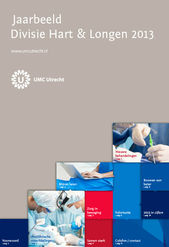
-
Team Interactieve Media 2016

-
Jaarbeeld 2016 afdeling Genetica

-
Speerpunt Cancer Center

-
Jaarbeeld Urologie 2015

-
Jaarbeeld Cardiologie 2015

-
Annual Report Heart & Lungs 2015

-
Jaarbeeld Hart & Longen 2015

-
Duurzaamheidsverslag 2015, UMC Utrecht

-
Strategie facilitair bedrijf

-
Jaarbeeld Cardiologie 2014

-
Patient Centraal

-
Jaarbeeld divisie Vrouw & Baby 13/14

-
Heart & Lungs in business, annual report 2014

-
Hart & Longen in bedrijf, jaarbeeld 2014

-
Resultaten in balans

-
Jaarbeeld Cardiologie 2013

-
Annual report Cardiology 2013

-
Jaarbeeld Cardiologie 2013 A4

-
Jaarbeeld Hart & Longen 2013

-
Annual report Heart & Lungs 2013

-
MVO Magazine

The UMC Utrecht, therefore including the DH&L, aims to perform effective and relevant cutting-edge research to ensure top-quality care and education. To achieve this aim, it is part of an international network of engaged research partners. The UMC Utrecht collaborates with seven international partners in Brisbane, Hong Kong, London, San Diego, Stockholm, Toronto. Researchers of the DH&L participate in three of these.
National University (Hospital) Singapore
Prof. Dominique de Kleijn (Experimental Cardiology), Prof. Marc Vos (Medical Physiology), Prof. Gerard Pasterkamp (Experimental Cardiology), Prof. Pieter Doevendans (Cardiology).
Various studies fall under the UMC Utrecht campaign 'Circulatory Health'. Collaborations are ongoing on biobanks, biomarkers, animal models, clinical trials, student exchanges (PhD students, Fellows and Medical Doctors)
University Center San Diego
Prof. Pieter Doevendans, Dr Joost Sluijter (Experimental Cardiology)
Fellows: Dr Alain van Mill, Dr Sailay Siddiqi, Dr Roberto Gaetani
The studies fall under the UMC Utrecht campaign 'Circulatory Health'. Collaborations are ongoing on tissue engineering.
University Center London
Prof. Folkert Asselbergs (Cardiology)
Collaborations are ongoing on research, including health informatics, biobanks, and genetic phenotyping of patients, and education, including the joint ' Elevate Health ' summer school and a shared 'Big Data Science' master’s program.







'Where in the DNA do things go wrong? Our research to identify genetic pathways that lead to heart disease is trying to answer this question. DNA consists of combinations of the letters ACGT. Together these encode the proteins in all cells. This letter code allows for many different variations.
The UMC Utrecht supplies us with many DNA variations obtained from blood samples of cardiology patients. The question is which ones exactly cause heart disease, and this is what we are testing in zebrafish. We introduce the DNA variations we find in the DNA of the cardiology patients in these fish to find out what happens.
Firstly, we have found that 80% of the human disease genes is also present in zebrafish DNA. Secondly, zebrafish embryos are transparent which makes it easier to study heart and heart-structure development as we do not need to cut.
Our zebrafish embryo heart-development research has shown that the heart does not grow by cell division of existing heart cells (as we used to think happened), but through aggregation of new cells that differentiate into heart cells and then develop further. One of the conclusions is that things go wrong when insufficient cells are added to the heart and babies are born with congenital heart disease.
We are mainly interested in the genes that cause arrhythmias, and to find out more about these we are working closely together with researchers at the DH&L Department of Medical Physiology. Once we notice that the letter 'T' in the DNA of this patient group has changed to one of the other letters in the AGCT code, we also introduce this mutation in the zebrafish. We then investigate whether the fish has the same symptoms as the patient with arrhythmias, such as slow heartbeat or poorly functioning sinoatrial node.
Once we know the exact target in the DNA, we may be able to use this in the future to accelerate the diagnosis, develop preventative therapies and new treatments. Preventative defibrillator implantation could, for example, be an option. New medicines can be developed on the basis of genetic information about arrhythmias, for example medicines that recover errors in an ion channel that causes abnormal signal propagation in the heart.
The only problem with DNA research is that it is looking for a needle in a haystack. In humans, 99.9% of the DNA is the same, while only 0.1% is different. And we want to find the one DNA variation or indeed a combination of DNA variations that causes the disorder in this 0.1%. These genetic zebrafish models may start to play a significant role in elucidating this, but there is still a long road to travel.'
Publication of zebrafish article as a link in this report
Strate I, Tessadori F, Bakkers J . Glypican4 promotes cardiac specification and differentiation by attenuating canonical Wnt and Bmp signaling. Development. 2015 May 15;142(10):1767-76.)

Team Interactieve Media 2016
Jaarbeeld 2016 afdeling Genetica
Speerpunt Cancer Center
Jaarbeeld Urologie 2015
Jaarbeeld Cardiologie 2015
Annual Report Heart & Lungs 2015
Jaarbeeld Hart & Longen 2015
Duurzaamheidsverslag 2015, UMC Utrecht
Strategie facilitair bedrijf
Jaarbeeld Cardiologie 2014
Patient Centraal
Jaarbeeld divisie Vrouw & Baby 13/14
Heart & Lungs in business, annual report 2014
Hart & Longen in bedrijf, jaarbeeld 2014
Resultaten in balans
Jaarbeeld Cardiologie 2013
Annual report Cardiology 2013
Jaarbeeld Cardiologie 2013 A4
Jaarbeeld Hart & Longen 2013
Annual report Heart & Lungs 2013
MVO Magazine
